Festive Food Favorites! The Eternal Triumph of Goodness Over Evil. The Changing Lights of Diwali.

Festival Food Favorites!
This collection of cherished memories and recipes from food enthusiasts is sure to put you in the mood for the holidays.
Compiled by Sucheta Rawal
Kheer: Nothing beats my late Grandma’s Punjabi recipe!
Growing up in northern India in a multi-religious household meant that I had the rare opportunity to celebrate many festivals with equal enthusiasm.
Each year, during Christmas, I dressed up in my finest and attended midnight mass with my grandma at the Catholic church where we ate decadent rum-flavored fruit cake and sipped on hot chai on freezing evenings in Chandigarh. On Shivratri, I offered milk at the Hindu temple and took home bright orange drops of boondi prasad. On Gurupurab, we gathered with friends at a community langar at our neighborhood Gurudwara for a simple yet heartwarming meal of puffed thin pooris, spice-smothered chana masala, and moist-rich sooji halwa. On Eid, our Muslim friends would gift us a portion of their sacrificed goat which my grandma would turn into flavorful mutton shami kebabs that made me hover around the kitchen for several hours in anticipation.
Food is an integral part of our memories, especially the ones that center around family, friends, and celebrations. The family matriarchs often hold the responsibility to carry on traditions and pass down recipes. It is no surprise then that each one of the contributors below credits a mother or a grandmother for their recipes.
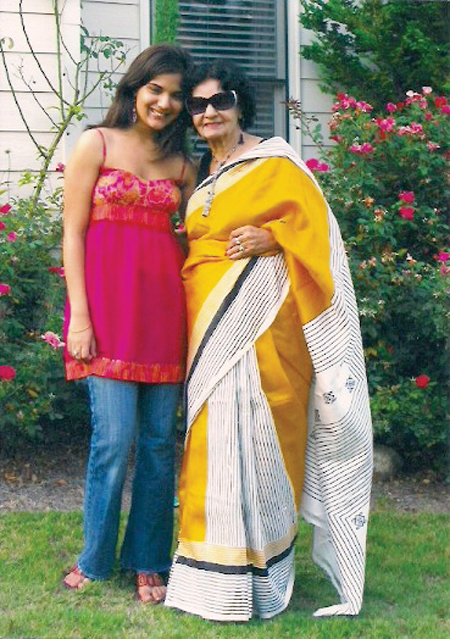
However, with time and place, rituals and traditions often go through transformations. When I moved to the U.S., I no longer welcomed unannounced guests with a tray of hot and cold beverages, and homemade sweet and savory snacks. For Diwali, potluck dinners became necessary to share cooking responsibilities. We postponed celebrations to weekends and modified recipes for faster cooking times.
Still, there are some dishes that most of us feel nostalgic about—so much so that we are willing to exert the time and labor for them. For me, it is kheer, a dessert that my grandmother always made at birthdays and festivals. It is a simple dish with only a few ingredients, but my grandma purchased each of them in the highest quality, especially for the occasion.
[Right] “The family matriarchs often hold the responsibility to follow rituals, carry on traditions, and pass down recipes. It is no surprise that each one of the contributors below credits a mother or a grandmother for their recipes,” says Sucheta Rawal, seen here with her late grandmother.
Over the years, I have traveled around the world and discovered that the versatility of rice and milk makes for a universal dessert. It may be known as kheer in India, arroz con leche in Central and South America, rizogalo in Greece, and rice pudding in the U.S., but the essential idea is the same—to use leftover rice and turn it into something luscious. Some recipes include cinnamon, others leave out the raisins, and the consistency may vary.
But the best version, for me, is this—my late grandma’s Punjabi recipe modified with Italian arborio rice. My kheer thickens within an hour, offering a rich smooth texture without having to add any cream or condensed milk. The updated version reflects my own universal palate.
Kheer with Arborio Rice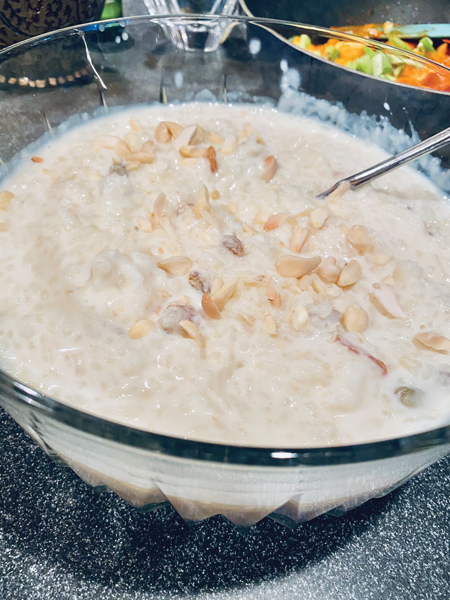
(Serves 8–10)
Prep Time: 5 minutes
Cook Time: 1.5 hours
Ingredients
- 3 cups water
- 1 cup arborio risotto rice
- 8 cups whole milk
- 5-6 pods of cardamom
- ½ cup sugar
- ¼ cup raisins
- 2 tablespoons sliced or slivered almonds
Method
- In a large microwave-safe bowl, add the rice and water. Cover with plastic cling wrap and poke holes with a knife so the steam can evaporate. Microwave on high for 6-8 minutes until the liquid is completely absorbed. Remove the cover and let it cool to room temperature before proceeding.
- In a heavy-bottom large pot, bring the milk to a boil. Add the cardamom. Turn the heat to low and simmer for 10 minutes, stirring frequently using a rubber spatula. Add the cooked rice and continue to simmer for another 45 to 50 minutes, stirring frequently and mixing in the cream that collects on the top.
- Add the sugar and continue to simmer for another 5 to 10 minutes, until the consistency is thick.
- Add the raisins and mix again.
- Chill the kheer for at least 4 hours or overnight, and garnish with almonds before serving.
(By food and travel writer Sucheta Rawal. Discover more of her recipes on her award-winning blog www.goeatgive.com.)

Sheero: My connection to my Gujarati heritage growing up in the Midwest
Like many first-generation Indian-Americans, I didn’t always find it easy to seamlessly connect my Gujarati heritage with my Midwest upbringing. One of the ways my family remained in touch with our culture and religious traditions was by creating a community with other Indian-Americans in our area. Late summer through fall was always a memorable time of the year since we’d gather frequently to celebrate festivals such as Krishna Janmashtami and Diwali. Of course, plenty of delicious sweets and snacks would be served at these celebrations, with each family contributing their own specialty.
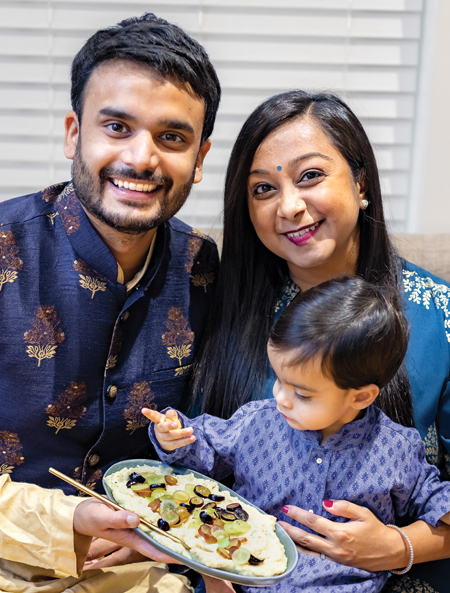
One of my favorite sweet dishes prepared by my ba (grandmother) was sheero, a classic pudding made from sooji or rava, the cream of wheat or semolina. It would often be topped with a tulsi leaf, the holy basil, for fragrance; and alongside the sheero, there would always be fresh grapes, which tasted wonderful with the warm sheero, when eaten in a single bite.
My variation is also completely vegan as it uses extra virgin olive oil as a more conscious alternative to the large quantity of ghee that is traditionally used in this dish. The fruitiness of the olive oil pairs particularly well with the grapes and cardamom in the recipe. This festival season was the first during which I’ve been able to prepare this dessert for my son, and he absolutely loves it! I look forward to making this during the festival season for many years to come as a way of passing on a piece of my heritage to the next generation.
[Left] Sheil with his wife and son, enjoying sheero. (Photo: Sheil Shukla)
Sheero with Grapes and Basil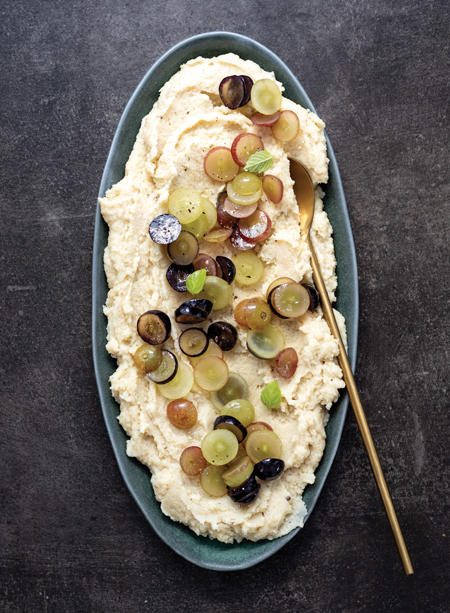
(Serves 4 to 6)
Prep Time: 5 minutes
Cook Time: 15 minutes
Ingredients
- 2 tablespoons extra virgin olive oil
- 1 cup (165 gm fine sooji or rava (cream of wheat or semolina)
- 1/3 cup (75 gm) cane sugar
- ½ teaspoon freshly ground cardamom
- 2 cups (480 ml) unsweetened plain nondairy milk (such as soy or oat)
- 1 cup (150 g) halved grapes: black, red, green, champagne, or any other variety
- 6 holy basil (tulsi) or basil leaves
Method
- Heat the oil in a wide nonstick pan over medium-high heat. Add the sooji, reduce the heat to medium, and toast until golden brown and fragrant, about 10 minutes. Stir frequently with a heat resistant spatula and lower the heat to prevent burning, if needed.
- Stir in the sugar, cardamom, and milk, and continue to stir continuously until thickened and separating from the pan, about 3 minutes.
- Serve immediately in a serving bowl, topped with grapes and basil.
(By Dr. Sheil Shukla, Chicago-based internal medicine physician, recipe developer, food photographer, and author. Follow him on Instagram at @plantbasedartist. Recipe from Plant-Based India: Nourishing Recipes Rooted in Tradition © Dr. Sheil Shukla, 2022. Reprinted by permission of The Experiment.)

The comfort of Khechidi and Khatta: Memories of Durga Puja celebrations in Odisha
There is a saying in Odia, the language of Odisha, “Bara mase tera parba.” It means that within 12 months, there are 13 festivals celebrated in the state of Odisha!
I grew up in Odisha and looking back, I feel we celebrated a lot more than 13 festivals each year. Among all the festivals, Durga Puja was probably my favorite. Durga Puja is usually celebrated for four days. But at our household, the celebrations went on for almost 10 days. During that time, we always had a full house. My paternal uncles and aunts came to stay and celebrate Durga Puja at our home along with their entire families, while other maternal relatives visited us during those days. It was a great time for the extended families to get together and bond with each other—a family reunion or an Indian version of Thanksgiving dinner of sorts.
On the first day of Puja, called Saptami, the special idols of Durga were moved to a beautifully decorated stand and the entire family came together to offer pushpanjali, a combination of flowers, rice with turmeric, duuba grass, and berry leaves, to Ma Durga and recite shlokas. We did this multiple times a day until the last day of Durga Puja, known as Dasami.
Food is also a big focus at any festival in Odisha.
Lunch was a feast of 10 to 15 unique dishes prepared in large quantities for 30 to 40 people. These dishes were first offered to the Gods for blessing. Although each meal included a big variety, one thing common for the lunch menu was khechidi, a rice and lentil porridge; and khatta, a sour or sweet and sour chutney. For me, these became my comfort food for the rest of my life. Over the last 40 years, even while living in the United States, I make these two dishes every time I am reminded of
home, and especially during the festival season. If I have guests over, I ask them their preference for sweet or savory and adapt the recipe, just the way my mother did as she watched out for every family member’s taste preference.
Tomato Khatta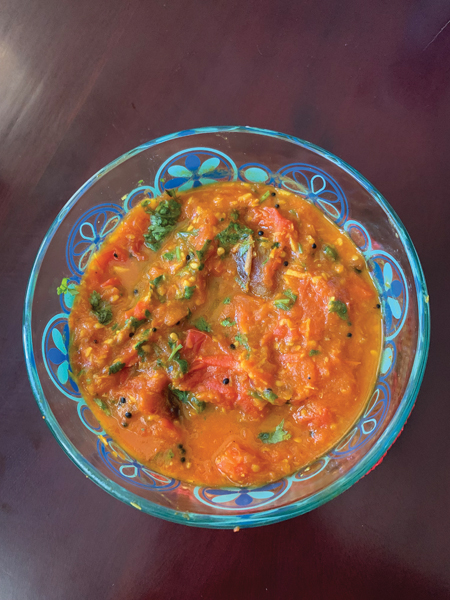
(Serves 8-10)
Prep Time: 10 minutes
Cook Time: 20 to 25 minutes
Ingredients
- 1 lb ripe red tomatoes
- 12 pitted dates
- ¼ teaspoon mustard seeds
- 2 whole dried red peppers
- Small bunch of fresh curry leaves, stalks removed
- 1 inch fresh ginger, grated
- ¼ teaspoon turmeric powder
- ¼ teaspoon cayenne pepper
- ¼ teaspoon cumin and red pepper powder, dry roasted and ground to make powder (optional)
- ½ teaspoon salt (more if tomatoes are sour)
- Small bunch of fresh cilantro leaves, chopped
- 1 teaspoon vegetable oil
- ½ cup sugar (per taste)
Method
- Heat the oil in a medium pot.
- Once hot, add the mustard seeds and whole red pepper. Wait for the mustard seeds to splutter. Then add the curry leaves and ginger. Reduce the heat to medium. Stir and make sure nothing burns.
- Add the tomatoes, salt, turmeric, and cayenne pepper. Cover and cook for approximately 15 minutes, stirring occasionally.
- Add the pitted dates and sugar. Cover and cook until tomatoes are completely cooked, stir occasionally. This may take another 5 to 10 minutes.
- Add the roasted cumin red pepper powder (if used).
- Garnish with chopped cilantro.
Khechidi: Odisha style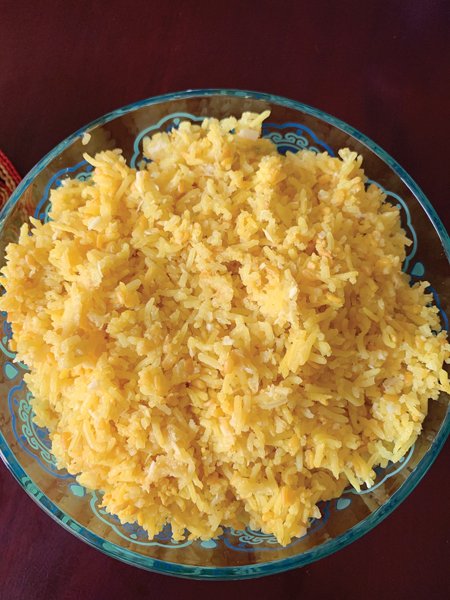
(Makes 10 servings)
Prep Time: 10 minutes
Cook Time: 20 to 25 minutes
Ingredients
- 1 cup basmati rice, washed
- ¼ cup yellow moong dal, dry roasted
- ½ teaspoon salt
- 2 bay leaves
- ¼ teaspoon turmeric powder
- 2 tablespoons ghee
- ½ cup grated coconut (fresh; thawed at room temperature if frozen)
- ¼ cup sugar (or less)
Method
- Boil 3 cups of water in a pot. Once the water starts to boil, add the bay leaves and turmeric. Let the water come to a rolling boil. Add the washed rice and moong dal and bring it to a boil. Reduce heat to low. Cover the pot leaving it slightly open and stir occasionally cooking for 10 minutes.
- Add salt, coconut, ghee, and sugar (as per your taste) and cook for another 10 minutes, until all the water is absorbed and the rice turns soft. Turn off the heat and place a lid on the pot. Let it sit covered on the stove for another 5 minutes.
(By Las Vegas-based Swadha Rath, a project manager by day and a home chef who enjoys baking, cooking, and feeding others by night.)

Chicken Keema Matar: Reminiscing a childhood spent in Zambia, Central Africa
Growing up in Zambia in Central Africa, our immigrant Indian community created our own traditions that we celebrated together at the Hindu Temple and at different high schools. Some of these included dandiya raas for Navaratri and karva chauth for married women.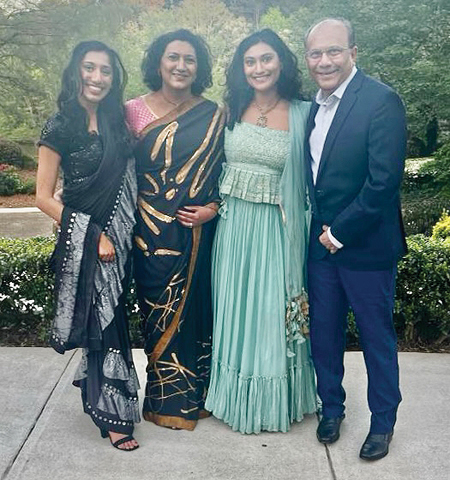
My parents instilled values in my brother and me that seemed more spiritual than religious. But we celebrated the festival of Diwali, Holi, Raksha Bandhan, and Dusshera for their cultural significance, keeping our roots alive. Like most other Hindu families, we met up with friends, feasted on the traditional meal of chhole puri, aloo subzi, and paneer matar, and burst firecrackers.
[Left] Poonam Nath carried her Indian immigrant traditions from an upbringing in Zambia into her life in the United States, altering her family dinner to include her daughters’ culinary preferences.
I carried this tradition into my life in the United States, altering our family dinner to include my daughters’ culinary preferences. For Diwali, they requested to have their nani’s—my mother’s—chicken keema matar recipe. My husband, who shares my values, also agreed that we won’t follow the traditional norm of eating only vegetarian food on Diwali. We realized that festivities are meant to enjoy what and who we relish most in life while being true to ourselves. To balance customs with lifestyles, our families observe vegetarianism throughout the day until prayers. Then, for Diwali dinner, we cook our favorite dishes: chole, parathas, paneer with bell peppers, and keema matter, along with sweets.
Chicken Keema Matar
(Makes 6-8 servings)
Prep Time: 10 mins
Cook Time: 45 mins
Ingredients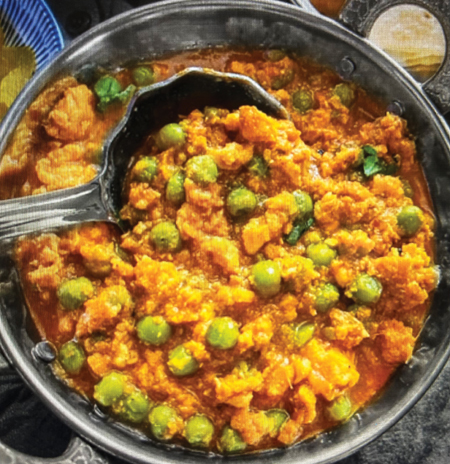
- 2 lbs ground chicken
- 1 cup frozen peas
- 2 large onions, thinly chopped
- 1 tbsp ginger paste
- ½ tbsp garlic paste
- 2 tbsp vegetable/canola oil
- ½ cup plain yogurt
- 1/3 cup water
- 1 tbsp fresh cilantro, chopped
- 1 bay leaf
- 3 green cardamoms, crushed
- 5 cloves
- 6 black peppercorns
- 1 tsp cumin powder
- 1 tsp coriander powder
- ¼tsp cinnamon powder
- 1 tsp garam masala powder
- 1 tsp red chili powder
- Salt, per taste
Method
- In a deep pan, heat oil on high heat. Add all the whole spices, stir, and reduce the heat to low.
- Then, turn up the heat to medium. Add chopped onions and sauté till golden brown, 5 minutes on medium heat.
- Add ginger-garlic paste and sauté, 1 minute on medium heat.
- Add ground chicken and sauté until no more pink shows, 3 minutes on medium heat.
- Add peas and sauté everything evenly until meat is nicely browned, 5 minutes on medium heat.
- Cover the pan with lid, reduce the heat to low, and cook for 6 minutes. Keep stirring every minute.
- After 6 minutes, remove the lid. The meat should have tenderized by now. Add all powdered spices, cover with lid, and cook for another 5 minutes. After cooking the meat with all the spices, it will tenderize and give a flavorful aroma of spices.
- Now add yogurt, sauté evenly, and cook covered, 3 minutes on low heat.
- Remove cover, add water, stir everything, and cook for 2 minutes over medium heat.
- Turn off the heat. Transfer to a serving bowl and garnish with fresh cilantro.
- Serve warm with plain white rice or roti.
(By Poonam Nath who enjoys cooking whenever she needs a break from her operations job in corporate America.)

Punjabi Chhole: As CNN/HLN food and wine producer, I sample variety of cuisines. But this remains my Diwali staple.
Diwali is always a festive and colorful time of the year for my family. My husband is Caucasian and an avid supporter of my culture (I mean, come on, have you seen the spread on Diwali? Who wouldn’t support that?)
Diwali also tends to fall around Thanksgiving. And that’s where I play festive ping-pong, punting from one house to the other, between turkeys and laddoos, scoring on all food fronts. My parents and in-laws conveniently live in the same city, so visiting both homes is easy enough.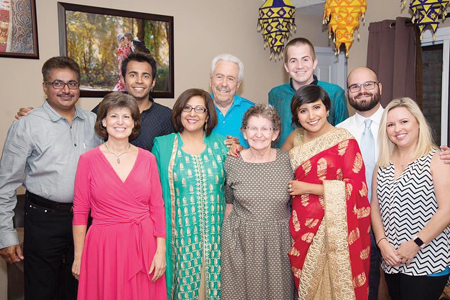
Diwali, at my parents’ house, begins with a symphony of vacuum cleaners and blenders blitzing chutneys. The kitchen comes alive with whistles from the pressure cooker, the knife hacking on the cutting board, and a stand mixer kneading fresh dough. We’re all bribed with promises of a multi-course dinner and sweets. From years of experience, I know exactly what’s cooking—Diwali is incomplete without my mother’s Punjabi Chhole Bhature.
[Left] Henna Bakshi enjoys sharing culinary delights from her Indian background with her biracial family.
Once the house is clean, my father begins preparations for pooja. That includes gathering fresh flowers from the garden, my mother making rangolis at our doorsteps, and presoaking diyas in water. The whole day goes by with a constant humdrum of activity which reaches its crescendo in the evening. We all get ready in new festive apparel, an assortment of food lines the counters and tables, diyas line the driveway and doorsteps, but the noisemakers aren’t the fireworks.
The made-from-scratch dough for the bhatura that is pampered all day with rest and kneading, hits the hot oil. It’s at that moment that the chhole are transferred from the pressure cooker to the serving bowl. It’s when mom says, “Sit down, the food is hot” and we all dig into the spicy and tangy chickpea curry that is a staple in North India. As with most mothers’ recipes, this is my best attempt at translating my mom’s directions—which are usually done by finger measurements instead of cups and spoons, using subjective descriptions like “thoda,” “bahut saara,” and “kadchhi jitna.”
Punjabi Chhole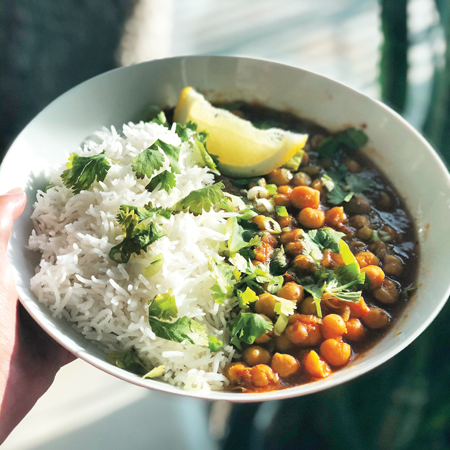
(Serves 8)
Prep time: 12 hours
Cook time: 1.5 hours
Ingredients
- 1.5 cups dried kabuli chana (chickpeas)
- 10 cups water (5 for soaking, 5 for pressure cooking)
- 3 tbsp cooking oil
- 2 tsp cumin seeds
- 1 medium white onion, finely diced
- 3-4 medium tomatoes, diced
- 2-3 tbsp crushed tomato
- 4 cloves garlic, grated
- 2 inches ginger root, grated
- tsp turmeric powder
- 1 tsp red chili powder
- 2 tsp chhole masala
- Salt to taste
- 2 tsp tamarind concentrate, 4 tsp hot water
Method
- Soak kabuli chana overnight with a dash of baking soda.
- After soaking, wash the chana and then pressure cook with at least 5 cups of water, until the chickpeas are tender. Usually about 25 minutes in an electric pressure cooker on high heat.
- Separately in a bowl, add hot water to tamarind concentrate and mix.
- In a medium-sized pan, heat oil on medium high heat. Add cumin seeds and cook until fragrant and slightly browned.
- Add onions, sauté until translucent. About 5-7 minutes.
- Add grated ginger and garlic, cook for about 30 seconds, being careful not to burn the mixture. Lower heat to medium, if needed. Add all dried spices except for salt.
- Once spices are fragrant, add diced tomatoes. Cook for a few minutes until tomatoes have oftened, then add the crushed tomato. Season with salt. Cook for about 6-7 minutes, until the oil has separated from the tomatoes.
- Add tamarind mixture and stir. Cook for about 3-4 minutes.
- Once the chickpea is cooked in the pressure cooker, add the mixture from the pan to the cooker. Simmer to combine all flavors together. Check for seasoning and adjust.
- Garnish hot chhole with diced onions, tomatoes, chopped cilantro, and lemon juice. Optional drizzle of saunth and cilantro-mint chutney. Serve with fresh bhature, naan, or basmati rice, and a side of raita and cucumber salad.
(By Henna Bakshi who covers everything food and wine as a producer at CNN/HLN. Follow her on Instagram: @HennaBakshi for pairing advice.)

The Eternal Triumph of Goodness Over Evil
Existential threats from a rapidly deteriorating environment, political acrimony, widespread anxiety and neurosis due to the breakdown of families and communities, wars . . . the state of the world appears dire and dark. But Diwali is a reminder that no matter how hopeless it may seem, truth always prevails, and light always, eventually, triumphs over darkness.
By Devidasi Dillard-Wright
Rivers around the world, from Colorado to the Yangtze, are running dry, laying bare vast patches of parched, cracked earth. From the southwestern United States to Andhra Pradesh and Maharashtra in India to China’s advancing Gobi desert, human influences on the earth’s climate make it more difficult every day for water administrators to supply enough “liquid gold” for farms and urban households.
In the political sphere, bribery, in the form of campaign contributions, has been legalized in the United States. Laws these days are written by corporate lobbyists and simply rubber-stamped by an ineffectual and corrupt Congress.
Regional wars threaten to break into world conflagration as they are stoked by the military-industrial complex and their backers in government. Warmongers use ethnic and racial animus, along with a massive propaganda machine in the form of sold-out media, to foment conflict for profit. The heavy price for such orchestrated wars is paid by “liberated” countries like Libya, Iraq, and Afghanistan. One wonders if Ukraine will become another shattered wasteland or if Taiwan will become the rallying cry for western profiteers.
People fleeing for their lives due to climate change, cartel violence, and civil war have not been given sufficient quarter in the so-called “civilized” nations—the very same nations most responsible for climate change and postcolonial violence. Migration, historically the most effective means that human beings have for avoiding disaster, has been artificially closed as an escape route by bigoted Americans and Europeans.
But Europe and America will also suffer. Every major city in the U.S. and Canada now has a housing crisis so severe that ordinary people can no longer afford to own a home or even rent. Service workers have no choice but to couch surf with friends or relatives or live in their cars. All of this chaos is due to private equity moving into the housing market—now they rent homes at exorbitant rates or simply leave homes empty, stored like gold bricks in a vault.
The constant atomization of society, which has been occurring since the Reagan-Thatcher era, has led to an epidemic of loneliness, together with opioid deaths and declining life expectancy. The education and healthcare systems can no longer effectively respond to societal breakdown and are constantly in crisis mode. Despair has become palpable, which makes insurgent fascism and white nationalism more popular which, in turn, leads to the scapegoating of marginalized communities like immigrants, LGBTQ, and BIPOC people.

In times like these, it can be very difficult to feel like celebrating the victory of light over darkness. Sometimes it feels like the light has vanished altogether.
But still, we light the lamps, offer fruit and flowers, and burn the incense. We welcome the light of divinity into our homes and into our hearts. We remember Hanuman burning down the demon city in Lanka and going to rescue Sita in the Ashok Vatika. Diwali reminds us that we carry light in our own hearts, that conscience and truth are active forces in the world, and that we, too, can overcome personal and societal evil through expressions of selfless service and goodwill. The demon army of Ravana need not win in our time.
But we have to learn to look with our hearts and not with our eyes. The Ramayana reminds us that the demon city is filled with vast temples and beautiful palaces. Ravana himself was a great devotee and priest of Shiva. We must not confuse material wealth with goodness and divine blessing. We must not equate worldly power or pious religiosity with divine merit. The scriptures teach—not just Hindu scriptures but all of the holy texts of the world—that goodness resides in a loving and generous heart that cannot be bent to cruelty or hatred. Rama gave up the palace life and willingly submitted to wandering asceticism with Sita and Lakshmana in order to preserve peace and uphold his family. Rama valued principle over wealth, truth over gain.
The dharma lies not in lust for power but in the good of all, including the good of the natural world and all living creatures. When Rama returned to Ayodhya, the poor were no longer oppressed, and everyone had enough to eat. Not only the human beings but even the animals, in fact the nature itself, joined in his coronation. Ramrajya, the rule of justice, happens when society is rightly ordered to the well-being of all people and reverence for the natural world. The loss of this central principle has brought about our current darkness, and the retrieval of this principle provides a way out. We celebrate Diwali to rekindle our faith in goodness and truth, to recover a sense of possibility that things can be better and that we have a part to play in making that happen.
The law of karma remains in effect. Humanity will pay a price for its careless disregard for the earth and its creatures. We will have to live for a while longer with our corrupt leaders and broken systems. The Kali Yuga, the age of strife, will continue.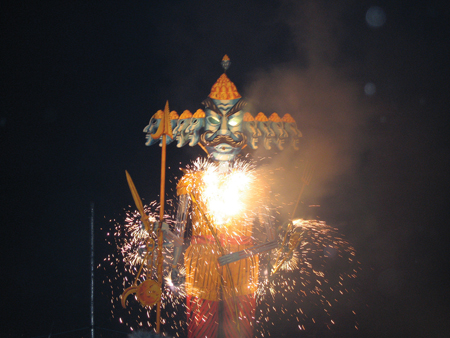
But if we awaken to the truth and live into our own best natures, Ramrajya will dawn again—if not for us, then for our descendants.
On a vastly different earth, in another place and time, goodness will reign. We work each and every day for that to happen. Just as Hanuman and Sugriva lent help to Dasaratha’s son, we too must aid and assist goodness in its wilderness sojourn. We must keep hope alive for a better world.
[Right] The ten-headed Ravana, the symbol of evil, no matter how unconquerable he may seem, will eventually always burn to ashes. (Photo: Ranveig, Flickr)
The headlines of war and drought, hunger and homelessness reflect the outer reality. And make no mistake, these outcomes are a product of human greed and will persist for a time. But another reality, the one seen in the deities on the altar, reminds us that somewhere within the human heart lies the possibility for kindness and compassion. We seek to allow these good, divine qualities to come to the forefront, to become the best representatives of the dharma that we can become. As we celebrate Diwali, we do so with the purpose and intention of defeating evil both in our personal lives and in our societies. We hope to usher Rama out of the wilderness and onto the throne of Ayodhya.
Devidasi B. Dillard-Wright, Ph.D., the author of Self-Love: 100+ Quotes, Reflections, and Activities to Help You Uncover and Strengthen Your Self-Love, is a devotee of Shri Maa of Kamakhya and Swami Satyananda Saraswati of Devi Mandir in Yuba City, California.

The Changing Lights of Diwali
How have the celebrations changed over a generation? What are the thoughts and sentiments of the young, new generation towards Diwali?
By Poornima Narayanan
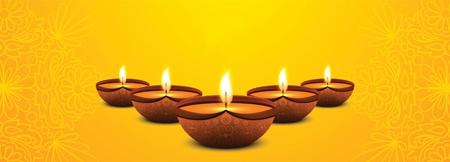
“She doesn’t want a silk sari or even a small gold chain, can you believe it? Just get me a new mobile phone, Ma, she says!” My friend rolls her eyes at her millennial’s choice of Diwali gift. I crack a sympathetic smile.
Riding back from shopping, we exchange reminiscences of Diwali from our youth. My own sepia-tinted memories go back to Chennai. In southern India, the religious aspect of the festival begins at the crack of dawn with the bursting of firecrackers symbolizing the gory end of the excessively ambitious and egoistic Narakasura. A ritual oil bath would be followed by a hearty breakfast; and the day would then spin out lazily and with much bonhomie in the company of family and friends.
At dusk, little mud lamps would shimmer all around the house. Dressed in festive gear, adults and children would burst a variety of firecrackers—the word “pollution” clearly did not exist in anyone’s vocabulary! It was a happy, enchanted interlude in the last quarter of the year that left in its trail, a wave of goodwill and warmth.
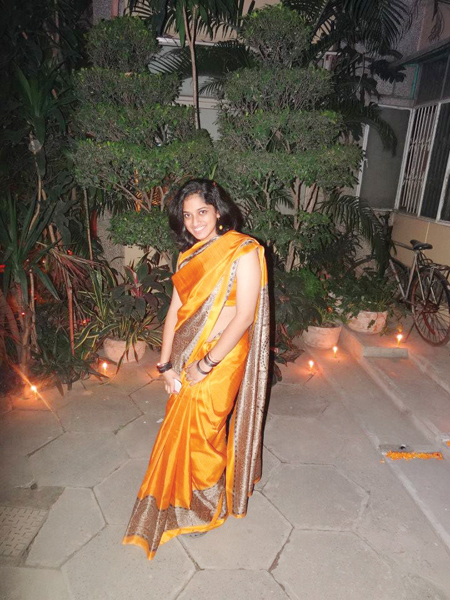
Those were simpler times. Moving to Delhi in the 1990s, I was in for a culture shock. By mid-decade, with the liberalization of the economy, the fortnight preceding Diwali had morphed into a period of consumption-fueled, manic celebration. Corporates and businesspeople took gifting to new levels. Roads, clogged with raucous traffic till late at night, sapped the fun out of visiting family and friends. None of this, though, dimmed the capital’s appetite for all-night partying and gambling.
Has India’s race to modernity changed the festival in some ways? How do our urban young, growing up in a globalized milieu, perceive and observe traditions of celebration and worship?
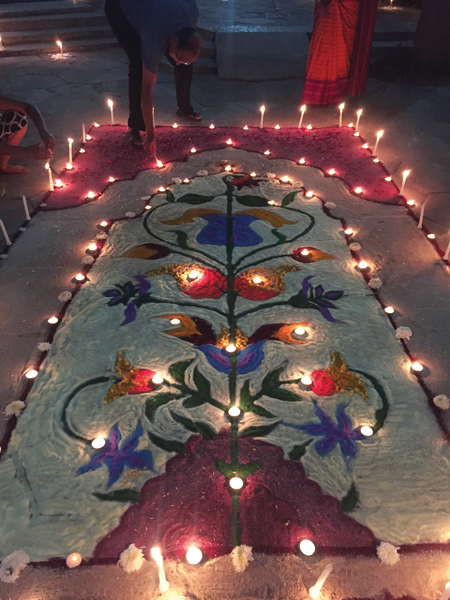
[Top] The author’s young friend, Manissha, says, “I wear something new and spend quality time with my family in the city.”
My young friend Manissha (23), a financial consultant, works away from her home city. Her nostalgic take on the festival: “Diwali makes me miss home and family. I get a day off from work, which is great. I usually celebrate with a few friends and relatives. There’s some sense of festivity in the air, even though it is now relatively subdued.
“I have a little tree with multicolored lights in my house that I place by the window to add to [create Diwali vibes]. I usually receive a parcel containing some homemade snacks and sweets which I preserve for as long as possible. I wear something new and spend quality time with my family in the city.”
Graphic designer Akshay Singh (27), who moved from Mumbai to Delhi for work, feels that the old ways of celebrating have changed dramatically. “When we were kids, the prep would start 10 days before the festivities. One day would go for [buying] clothes, another day for decorations, and then one more day to get things for the kitchen to make stuff. Nothing was outsourced from stores. We would be excited to see kaun kya patake leke aaien hain (who’s got which firecrackers).
Now it’s more about sitting at home and just ordering [things online]. Patake tho phodthe nahin hai (firecrackers are not burst anymore). And we involve our relatives a little less. Back then, we were very excited to go and meet our bua-s, uncles, and cousins. Now it’s different. I’ll probably go have a beer with friends, and not spend much time with family.
The rituals have changed. Back then, the puja used to be elaborate, now it’s a little short. We used to be more excited to sit for puja-s. Now, a mother knows her kids won’t stay so she finishes it quickly.” Akshay also recalls the Yam ka diya, a single mud lamp that would be lit and placed outside the house to ward off negativity. That ritual, he says, seems to have fallen out of practice.
Delhi-based Nishtha (22), a brand strategist and writer, sums this up niftily: “Diwali to me—at least throughout the year—seems like a beautiful time where things are all twinkly and lovely, people are happier, and the air smells like harsingar (a flowering tree with perfumed blossoms) for the entire month. But in reality, when the festive season hits, it’s all chaos and stress!”
How does she spend the festival days? “Usually working. Apart from that, it’s trying to avoid visiting relatives, gorging on mithais, cleaning my room (which usually turns into cleaning the house), decor and shopping for the said decor, Diwali card parties, slightly-too-much alcohol, and gifts, gifts, gifts!”
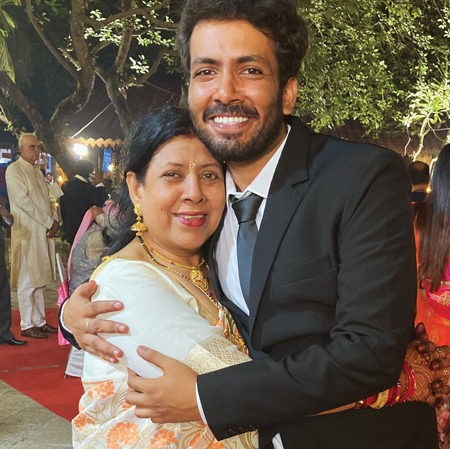
20-somethings Niva, Ayushi, and Parth were among the earliest generations in Delhi to be sensitized during school days to the link between their city’s air pollution levels and Diwali firecrackers. That initiative has paid off. “I used to look forward to playing with fireworks but now I prefer the part where we decorate with neighbors,” observes Niva.
[Right] “The rituals have changed. Back then, the puja used to be elaborate, now it’s a little short. We used to be more excited to sit for puja-s. Now, a mother knows her kids won’t stay so she finishes it quickly,” says graphic designer Akshay Singh, who is seen here with his mother.
Ayushi, an investment banker, echoes her, saying, “Fireworks are not good for the environment or animals. Having a dog changed my perception completely. Diwali is more about spending time with family and just being there for each other.”
Young lawyer Parth Singh enjoys lighting diyas and relishes festive food. As a child, he would look forward to visiting local theatres to witness Ramlila dramatizations.
Perceptions apart, much else has changed in recent times. With higher incomes, travel, and greater exposure to global cultures, even that most traditional of Diwali gifts, the mithai box, has given way to a host of non-traditional goodies. Wine-and-chocolate baskets or stylish hampers loaded with an eclectic collection of comestibles are par for the course in local markets and malls.
Where Diwali was once a homebound festival, a time for scattered families to spend time together, many younger people prefer to take off on vacation to the hills or beach resorts, away from their crowded and smoky city environs.
Come Diwali, homes will sparkle again this year, with clay diyas twinkling softly alongside fairy lights. Old traditions will live on and a new generation will invent new ways to celebrate the spirit of the festival. . . isn’t that how it has always been?
Poornima Narayanan is a Delhi-based freelance writer and editor.

Wishes sent on WhatsApp and Facebook replace neighborhood visitations yet the soul of Diwali remains intact
By Gitanjali Chak
“So what’s the big deal about new dresses on Diwali? We get them whenever we want to at any time of the year!” That’s Adhya K for you, a 12-year-old student from Coimbatore, Tamil Nadu expressing his excitement—or rather, the lack of it—as Diwali approaches. A sign of increasing prosperity where buying is a year-round activity and no longer limited to festivals, Adhya is not the only one who feels this way. Many from his generation are more enthused at the prospect of watching a new movie hitting the screens on Diwali day than wearing new clothes and bursting crackers. But are they to blame really?
With sustained campaigns in schools focused on increasing the eco-sensitivity of children, many of them try and desist from having a “blast” on Diwali, literally speaking, as fireworks are no longer on the wish list. In fact, this eco-consciousness has dampened, to some extent, the celebratory spirit of Diwali. After all, bursting crackers was the fun part of the festival that the kids used to look forward to. Green crackers are far too expensive for the middle class to serve as a substitute.
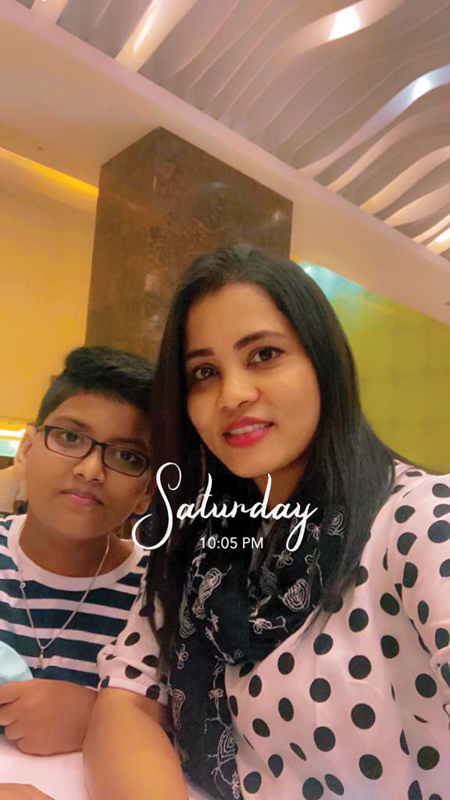
And then, if you don’t have relatives in the same city, you have to pretty much be content spending a quiet Diwali evening in your beautifully lit-up home, making most of the company you have—your immediate family, which may or may not include grandparents.
Adhya’s mother, Ramya Kumaresan, a teacher-turned-entrepreneur reminisces how, in her childhood, waking up at the crack of dawn and taking an oil bath was an absolute must, as was distributing sweets to neighbors on Diwali morning. “That would give us a chance to show off our new dresses! Interestingly, my mother would apply a pinch of turmeric powder at the corner of each new dress before we wore it. It is considered auspicious. Our day would end with a visit to our grandparents’ house to get their blessings and bursting crackers with our cousins.”
Cut to today. You wake up inundated with Diwali greetings on WhatsApp, Facebook, and the like, and then spend some time decluttering your phone, much in the same way you have decluttered your home before Diwali! But of course, not before some have flaunted their new Diwali outfits on social media and garnered a thousand “likes”!
There are, however, some youngsters for whom Diwali has retained its sparkle all these years. Says a 24-year-old girl from Kashmir, Anantya Harkauli, who is a post-graduate in Psychology, “My mother celebrates the festival in much the same way as my Nani used to . . . so we have a family puja, there are sweets galore, the house is bedecked with fairy lights, there is fun and bonhomie with relatives and friends, not to forget the new clothes. I would not have it any other way.”
[Left] Mother and son, Ramya and Adhya K, at a theater on Diwali day to watch a new release.
Speaking of fairy lights, that’s one change that is very visible in most homes in India. These strings of multicolored electric bulbs have become the norm, largely replacing diyas, the pretty terracotta lamps, which were earlier synonymous with Diwali. This probably has to do with the fact that making the wicks, dipping them in ghee or oil, and then lighting them takes much time and effort. And with joint families now increasingly giving way to nuclear set-ups, where are the extra hands that are required for this time-consuming process? So diyas mostly find their place at the entrance of the house, in select niches inside the home, and, of course, the puja place.
I remember I used to love collecting the tiny pools of melted wax that the candles would turn into the morning after Diwali. But will the new generation find this activity enthralling? I doubt. There may not even be so many candles to turn to melted wax!
Rajnish Sharma, a Lucknow-based journalist, has vivid memories of his mother making imprints of Lakshmi Ji’s padchinh, her footprints, right from the main door to inside the house using chaawal ka ghol, a liquid mixture of white rice. Today, however, one finds stickers of Lakshmi Ji’s footprints flooding the Diwali markets as an easy substitute for the original handmade footprints.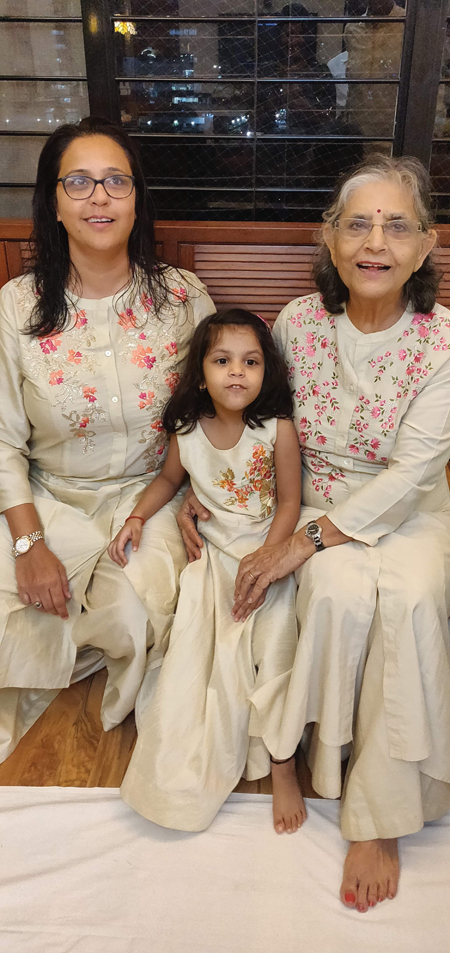
Says Arunita Goswami, a high school student, “Earlier I would spend hours making intricate rangoli patterns. But I just don’t have the time now, what with so many of the school projects that I need to complete. So, we just go in for readymade designs.”
The tradition of the Lakshmi-Ganesh puja, however, is a feature of Diwali that has endured all these years, and something that all families enthusiastically participate in. It is the very core of the festival and is always looked forward to by children as they are only allowed to gorge on the delicious sweets after the puja gets over with the aarti. In my childhood, the puja in the evening was presided over by our family guruji. After the genial old man passed away, my mother would lead the puja and now the mantle has fallen on me. Well, I do the best I can with help from my daughter. But it is certainly not that elaborate now.
Another thing that is not so elaborate now is the culinary aspect of Diwali. In the past, the Diwali dinner in many homes was a sumptuous spread of lip-smacking dishes like poori-kachauri, sweets, chhene-paneer ki sabzi—and not to forget—dahi-bada. Now, lack of help at home and app-driven food delivery services like Swiggy and Zomato have completely transformed the food scenario. All one has to do is to simply click to order Diwali delicacies. And it’s the youngsters in the family who decide what everyone will eat.
Says 75-year-old Rekha Kumar, an educationist, “I miss the days of yore when we exchanged humble gifts like kheel, batashas, a small mitti ki murti of Lakshmi-Ganesh, and a small quantity of sweets, with each other. It’s sad that gifting on Diwali has become a thriving business today which has robbed the festival of its purity and simplicity.” The aggressive Diwali advertisements on television and social media to promote this gifting culture to suit their business interests have dealt a body blow to the true spirit of Deepawali.
[Right] Three generations of the Kumar family: Rekha Kumar and daughter Mitu twinning in white, along with granddaughter Aryahi, on Diwali day.
To sum up, maybe we should leave it to Rekha’s daughter, Mitu, a Mumbai-based television personality, to have the last word on this, “More than the trappings, it’s the soul that matters and, hearteningly, despite all the changes that Diwali has seen over the years, its soul remains intact. Every family celebrates it and will continue to do so the way it deems fit. For me, personally, Diwali is like going back to childhood, connecting with the past, and keeping up with tradition in a non-traditional manner.”
Gitanjali Chak, a Lucknow-based journalist, is also the Bollywood columnist for Khabar. Written with inputs from Rajnish Sharma.
Enjoyed reading Khabar magazine? Subscribe to Khabar and get a full digital copy of this Indian-American community magazine.
blog comments powered by Disqus










